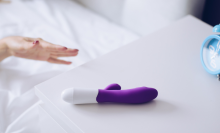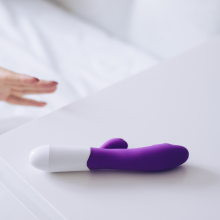This is the first story in a four-part series on sex hacks for the digital age.
The world of sex toys has never been more inviting, inclusive, and destigmatized than right now, offering new possibilities for women and other marginalized identities to explore their sexualities.
Or at least, that’s what should be happening in theory.
Over the past several years, a wave of feminist sex tech companies has revolutionized the male-dominated industry by redefining toys as part of sexual health rather than an illicit perversity. With groundbreaking products engineered for a wider variety of bodies, shame-free messaging, gorgeously empowering design, and anti-male gaze marketing, companies like Dame, Maude, Crave, and Unbound ushered us into a new era of pleasure tech.
“We're living through a golden age of sex toys, a kind of a renaissance where we have access to such incredibly well-constructed and innovative products,” said Ian Kerner, a sex counselor, psychotherapist, and author of She Comes First.
“We're living through a golden age of sex toys."
The trend shows no sign of stopping, either. A 2018 global market report projected the industry would reach $35.5 billion by 2023, tracing its growth to this repositioning and rebranding, and the public’s overall “increase in openness, drive for excitement and adventure, passion for quirky products and heightened desire for experimentation.”
Culturally speaking, the sex toy stigma grows more extinct by the day. But it hasn't wholly disappeared.
“The shame has lessened, but for some women buying a tool exclusively for their own sexual pleasure is still a big leap,” said Hallie Lieberman, author of Buzz: A Stimulating History of the Sex Toy. “A lot of women still don't think that they deserve that or that it will reflect poorly on who they are as a woman.”
To be fair to us, counteracting centuries if not millennia of internalized shame from heteronormative patriarchal society is tough. Many of us might not even fully realize where our hesitation to experiment with sex toys really comes from.
When sex toy company TENGA’s 2019 Self-Pleasure Report survey asked participants why they didn’t, 49 percent answered with a variety of expected anxieties and shame. But an overwhelming 54 percent simply said it was because they didn’t think they “needed” one.
Judging from the well-documented gender disparity in orgasms in heterosexual intercourse, though, it’s clear our notions of who “needs” to (or gets to) feel satisfied in the bedroom is not equal.
“One of the most common reactions to the thought of using sex toys if you haven’t before is, ‘Oh, those aren’t for me.’ At least, that’s the initial thought I had before I owned a vibrator and lubricant,” said Polly Rodriguez, now CEO and co-founder of her own sex toy company, Unbound.
(Note: We’re mostly focusing on heterosexual women and couples here because TENGA’s survey and the National Survey of Sexual Health and Behavior conducted by Indiana University both suggest LGBTQ folks — especially those with labias — are way ahead of the curve, disproportionately making up the demographic already participating in the sex toy revolution. In this rare case, the straights need more help getting past a heteronormative shame. For LGBTQ folks looking for advice, both Unbound's and Dame’s blogs publish fantastic LGBTQ-focused guides.)

As it turns out, despite years of slut walks and the anti-slut-shaming movement, the fear of being categorized as a hypersexual woman still rears its head. But not wanting to be one of “those” women who “needs” a sex toy goes even deeper than that.
It comes back to the historied, outdated (not to mention heteronormative) belief that women’s pleasure should only come from a man, and that her sexual awakening should happen with him during intercourse.
“It’s like, if I have to use this technology to get off, it feels like I’ve failed as a woman,” Lieberman explained. The focus on the phallus as a more “natural” form of female pleasure is why dildos that mimic the male anatomy were such a central focus of the sex toy industry for so long, despite the fact that many other types of toys — like those for clitoral stimulation — were found to be more satisfying to more women.
Some of women’s sex toy shame can be blamed on Freud, Kerner said. He incorrectly theorized that clitoral orgasms were an immature state of a woman’s sexual development, with properly functioning females eventually maturing into vaginal orgasms.
“He never described how this would happen,” said Kerner. “But there’s still this idea that somehow clitoral orgasms aren’t ‘real’ orgasms.”
"If I have to use this technology to get off, it feels like I’ve failed as a woman.”
Meanwhile, research suggests 37 percent of people with vaginas need clitoral stimulation to achieve orgasm, while only 18 percent said penetration alone was enough. Yet the unrealistic ideals of what women’s pleasure should look like persists, despite being incompatible with how most people with vaginas reach climax.
“What I hear from some women is that introducing a vibrator into sex is an indirect admission that something is wrong, that the intercourse isn’t working. And rather than thinking, ‘Well, there’s probably a good reason for why it isn’t working for me,’ they instead internalize that as feeling sort of broken or defective,” said Kerner. “So you have a lot of women coming in and asking, ‘What's wrong with me? Why can't I get off the normal way?”
This unconscious fear is closely tied to another common myth around sex toys: that they’ll replace human (presumably male) partners who can’t satisfy women as well as the technology.
Who can forget the Sex in the City episode when Charlotte needs a “Rabbit intervention” so she can stop getting off so much to her vibrator and go back to being in a real relationship. Lieberman even pointed to this trope being in one of the earliest Greek plays, Lysistrata, where women threaten to replace the men at war with dildos.
In the modern age, the fear that women will become so addicted to toys manifests in memes comparing sex toys to partners, or even Cardi B in Hustlers boasting that her pink vibrator is the best and only boyfriend she will ever need.

Women in heterosexual relationships still often worry that asking to introduce a vibrator or toy into the bedroom will make their partner feel emasculated. In his work with couples, though, Kerner has never found this to be the case, with “most men seeming very receptive to wanting to create experiences that are mutually pleasurable.”
If that’s a particular worry, though, partnered sex toys can alleviate the stress of making it about your pleasure alone.
The highly-rated (and also woman co-founded) Crescendo from MysteryVibe is ideal for beginners looking for versatility, designed for solo or partnered play, various positions, and various bodies and sexual orientations, too. For me, something as ingeniously simple, unintimidating, and Intuitive as Dame’s Fin was nothing short of revolutionary, leading to my first simultaneous orgasm with a partner ever.
“The new wave of sex toys have opened people up to the idea that toys and masturbation are not in opposition to a relationship. It’s not one or the other. Women don’t have a limited amount of sexual energy,” said Lieberman.
Still, the myth of sex toy “addiction” or that vibrators cause permanent desensitization or make it impossible to cum any other way persists. Luckily, there is zero empirical evidence to support these concerns.
"Women don’t have a limited amount of sexual energy.”
What’s funny, Lieberman noted, is that concerns over vibrators being addictive only started in the 1930s, once sex toys began being openly sold in markets rather than controlled by doctors. That’s when the concept of “dildo attachment” came into the conversation, which claimed to make women stop wanting sex with their husbands.
At worst, Kerner said, vigorous habitual use of a sex toy can simply cause over-familiarity with that specific intense sensation that can’t be replicated by a person. But that’s no different than men who develop difficulty climaxing during intercourse because they masturbate with a very tight grip that can’t be replicated during penetration.
Both are easily fixed with a simple break.
“Just stop using it for a few days. It’s not heroin. You can put it to the side, and use your hand or go manual with your partner, and it will return to being just as pleasurable,” said Lieberman.
One legitimate health concern, however, relates to the type of material used for sex toys. Rodriguez emphasized the importance of medical-grade rather than food-grade silicone, since they often go inside the most absorbent parts of your body. Be very wary of buying anything on Amazon, which often sells knock offs.
On the other hand (pun intended), what more masturbation can do is actually improve your capacity to orgasm in general, and give you the space to learn exactly what kind of touch and sensations you like, which you can then communicate to your partner.
But outside of its benefits in partnered sex, the power of sex toys is about rediscovering what pleasure means and feels like to you alone.

“I think masturbation is one of the healthiest things we can do when it comes to understanding and appreciating our bodies. For me, and for many in our community, self-pleasure helps us reclaim our bodies for ourselves,” said Rodriguez.
At 21, she underwent menopause after a cancer diagnosis and dealt with feeling estranged from her body. “For many who experience trauma, it can be a truly healing process to redefine your sexuality for yourself.”
Another more practical concern for first-time sex toy buyers, found in both the TENGA survey and Unbound’s own community survey, was price. Quality toys can be an investment, and the sheer variety of different types, sensations, and textures can feel paralyzing when you have no reference point for what you like.
That’s why the best first toys are reasonably priced, straightforward, and versatile (scroll to the bottom for our best recommendations). People with labias often find the most success when starting with clitoral stimulators like bullets or lipstick vibes. Unbound has a quarterly, affordable subscription box designed for newbies trying to expand their erotic repertoire.
One revolutionary policy Dame made in order to help get over this barrier to entry goes radically against a key industry-standard: They accept returns. (Unbound accepts partial returns for used toys).
“First of all, be proud of yourself for buying the toy.”
Their policy changed after CEO Alexandra Fine and her co-founder reevaluated the reasons behind this industry standard, which claims that returns are unhygienic. But the more they thought about it, it became clear that other companies accepted returns despite their product being unhygienic to resell, like Casper mattresses and Thinx panties.
“What that kind of policy is almost saying is, ‘Hey, your vagina is disgusting. Obviously, we can’t take returns.’ That in itself has shame built into it, and is counter to us creating a shame-free experience,” said Fine. “We want you to feel comfortable letting us know that something didn't work for you. Then, we can help you find something that does.”
Still, even when we can get over all those initial walls of shame and finally buy a sex toy, it’s very normal to then face a whole other wave of shame while actually using it. But there are lots of ways to get past that, too.
“First of all, be proud of yourself for buying the toy,” said Lieberman. “Then, accept that your first few experiences may be awkward. I mean, what was your first experience of sex with another person like? You don’t know what you’re doing. It's a new technology that you're learning. It could even feel weird at first if you've never had something vibrating on your genitals. That's OK, too.”
Try everything alone first, and on the lowest power setting first — possibly even over your panties or even a towel for clitoral stimulators. People vary on level of sensitivity.

Overall, one of the best pieces of advice I ever got while joining the sex toy revolution is to treat each new toy like a new sexual partner. Give yourself time to learn how it fits your body, or whether it’s a good match at all. View your early experiences as exploratory rather than setting the expectation to cum, which puts undue pressure on you and your new friend.
And honestly, unless you’ve purchased from one of these new women, femme, and non-binary-led sex toy makers, do your best to ignore the marketing and promises on the packaging. Often, you’ll find images of scantily clad women that project a false picture of what masturbation looks like. In reality, it looks more like you in pajamas and a face mask.
Even more importantly, do not believe in the promises of an instantaneous, guaranteed, melt-your-face off orgasm. Again, every body is different, and it’s normal for something that works for most to not work for you. If you’re confused about how to use it (since many manuals are woefully lacking), educate yourself online with reviews that paint more vivid pictures. Many of the companies that are revolutionizing sex toys also provide well-written blogs and step-by-step guides for their toys.
"Me Too let people — especially women — feel more comfortable expressing their need, their demand for sexual pleasure."
Underlying the new sex toy revolution is a movement that believes pleasure and satisfaction should be a human right. Closely tied to that movement is another one that started in 2017, which finally allowed women to start talking about the ways sex made them feel ashamed, traumatized, and silenced.
“The rise of talking about sexual assault from Me Too let people — especially women — feel more comfortable expressing their need, their demand for sexual pleasure,” said Lieberman.
It’s deeply unsettling (perhaps even related) that, in the midst of this sexual wellness revolution, we’re seeing a vicious legal backlash trying to strip women of basic rights over their own bodies. Whether it’s challenges to Roe v. Wade, other increasingly restrictive abortion laws, or less access to birth control, “at the bottom of it all is people preventing women from having sex without consequence. It’s the belief that sexual pleasure isn't good in and of itself for women unless it’s to procreate,” said Lieberman.
While it might seem silly (and obviously, different forms of activism are needed to counteract these serious threats), there is power in reclaiming at least one form of control over your body by exercising your right to pleasure with a toy.
“My suggestion is to just give it a try,” said Rodriguez. “I have yet to hear from someone who, after trying a vibrator, regrets it. It’s all about just giving yourself permission to explore — and you are the only one who needs to grant yourself permission, to say ‘yes’ to pleasure. Trust me, you deserve it. We all do.”
GREAT SEX TOYS FOR BEGINNERS

Maude
Minimalist, inexpensive, yet powerful, the Vibe’s exquisitely accessible design made it an instant hit for a reason. Its simplicity doesn’t sacrifice function, with a reputation for getting the job done fast. Able to be used externally or internally, it’s the most bang for your buck (and boy, does that buck go).

Mystery Vibe
A Swiss Army Knife of toys, this bendable, inclusive powerhouse justifies its price by letting you experiment in countless ways (their Playbook has some ideas). One con is its overwhelming app with a paralyzing amount of customization options. Like all Bluetooth-enabled toys, it drops connection often, so just preset your favorite patterns onto the vibe. Though I didn't try it, Unbound’s Bender might be a cheaper, simpler alternative for a similar concept.

Crave
Break the sex toy taboo with a gorgeous necklace that's also a pinpoint clitoral stimulator designed to get you off wherever and whenever you want. Wearing the Vesper turns your shame into an unapologetic pride. While not the most powerful, it's perfect for those nervous about introducing toys into partnered sex since unscrewing it from your necklace is sexier than fumbling for one in your bedside table.

Dame
In a word: life-changing. The simple genius of the Fin is that it puts the power of a bullet between your fingers, making it seamless to use in any position during penetrative sex and one of the best toys for closing the orgasm gap. Despite access to countless other vibrators 4 times more expensive, I dubbed Fin “old faithful,” cause I could always count on it like clockwork to deliver a geyser-level explosion.

We-Vibe
A personal favorite as my first vibe ever, the Tango’s been a classic, powerful, beloved bullet for years that's simple and gets the job done. If you're more sensitive to vibration, prefer the soft silicone feel, more fluttering sensation, or an adjustable tip, try Dame’s equally great Kip.

Womanizer
Worst name for one of the greatest gifts to clitorises, this legend uses suction instead of vibration. Lining it up is tricky at first, but once I did, the orgasm ripped forth from my body in seconds along with an involuntary scream. No toy is a guarantee for all, but this is the closest and an alternative for those not jiving with vibing. Premium includes a quiet motor and autopilot mode perfect for newbies. But cheaper models don’t disappoint.

We-Vibe
Honestly, I wouldn’t recommend rabbits for beginners because they look intimidating, are a bit unwieldy to figure out at first, and often not all they’re cracked up to be. But since it’s one of the most popular and well-known types, I suggest one of the only ones I found with enough bend, power, and adjustability to provide the amount of clitoral stimulation needed for a variety of bodies.
Read more from the series:
Topics Sex Toys Innovations































